When publishing feature is enabled in SharePoint 2010, the “Save As Template” option would magically disappear. A quick solution to this is by manually using the URL /_layouts/SaveTmpl.aspx
Info from here
Thursday, September 15, 2011
Thursday, August 18, 2011
Hide First Tab in SharePoint 2010 Navigation
I created a blog post on this for SharePoint 2007 HERE: But SharePoint 2010 is a bit more complex. Since it uses UL’s and Li’s for it’s navigation it is a bit harder to hide just one element.

You will notice that the Home tab actually is the first node and then has a child UL which represents the rest of the navigation Items. So the approach is to hide the first <li> <a> (display: none) and then simply just use (display:block ) to show the hidden <ul> <li> <a> tags.
Here is the CSS you could use to hide just the first node (home) tab in a SharePoint 2010 application:
.s4-tn li.static > a{
display: none !important;
}
.s4-tn li.static > ul a{
display: block !important;
}

Enjoy!
Information given by Erik Swenson

You will notice that the Home tab actually is the first node and then has a child UL which represents the rest of the navigation Items. So the approach is to hide the first <li> <a> (display: none) and then simply just use (display:block ) to show the hidden <ul> <li> <a> tags.
Here is the CSS you could use to hide just the first node (home) tab in a SharePoint 2010 application:
.s4-tn li.static > a{
display: none !important;
}
.s4-tn li.static > ul a{
display: block !important;
}

Enjoy!
Information given by Erik Swenson
Thursday, August 4, 2011
Sharepoint 2010 CSS Chart reference
This is a very interesting blog referencing every CSS entries you may need in styling sharepoint 2010
http://sharepointexperience.com/csschart/csschart.html?utm_source=spexp.me&utm_medium=urlshortener
http://sharepointexperience.com/csschart/csschart.html?utm_source=spexp.me&utm_medium=urlshortener
Monday, May 16, 2011
Easy way to Redirect Users to an Error Page in SharePoint
We as developers catch exceptions and try to gracefully educate our users on what might have gone wrong and what they are supposed do in the case of an error. If and how we notify the user depends largely on the type of exception as well as the type of SharePoint component i.e. Web Part, Event Handler etc.
Web Parts generally should show error messages within the web part. While event handlers will need to show the errors in a log perhaps. There is also another way, an easy way to show these type of errors.OOTB the WSS API provides a sleek one liner to handle things that go wrong in custom SharePoint components and show the system error page with our custom message.
The one liner:
You can even pass a link so the user has a choice to come back to the active\home page of the site and start again
Information given by Rai
Web Parts generally should show error messages within the web part. While event handlers will need to show the errors in a log perhaps. There is also another way, an easy way to show these type of errors.OOTB the WSS API provides a sleek one liner to handle things that go wrong in custom SharePoint components and show the system error page with our custom message.
The one liner:
SPUtility.TransferToErrorPage()
You can even pass a link so the user has a choice to come back to the active\home page of the site and start again
Information given by Rai
Tuesday, April 12, 2011
HOW TO:Forms Based Authentication (FBA) on SharePoint 2010
Information comes from Donal Conlon
There are not a lot of differences with configuring FBA for SharePoint 2010 compared to 2007, but there are a few. For instance, SharePoint 2010 no longer supports “classic FBA”, rather forms based authentication is provided through Claims Authentication. There is also the introduction of the Secure Store Service which is the next-gen of the Single Sign On service of old.
Both of these come into play when configuring Forms Based Authentication.
Mission
Configure an extranet web application for Claims based authentication using AD and Forms. Store membership credentials in a SQL database. Manage members through IIS Manager.
Game Plan
1. Configure SQL for membership store
- Create database
- Create SQL User
- Add SQL user to database
3. Configure Secure Store Web Service to use SQL membership store
4. Create new Web Application for extranet site
5. Configure Extranet site to use SQL membership store
So let’s begin…
1. Configure SQL for membership store
The process of creating the store is exactly the same as what we did for 2007, so I’ll just copy and paste that thank you!The membership store is still created using the ASP.NET SQL Server Setup Wizard. This is launched from the .NET 2.0 Framework folder on the server at:
C:\Windows\Microsoft.NET\Framework\v2.0.50727\aspnet_regsql.exe
This wizard will take you thorough the steps and will build out the SQL database for you.

Once you select to Configure SQL Server for application services, you will be prompted for the SQL Server name and database name. You can choose an existing database to add the membership elements to, or you can type in a new name and the database will be created for you.
Once the database is created, we’re going to create and add a SQL user, rather than use integrated authentication. If your SQL instance is not already running in mixed-mode, you can change it through Server properties in SQL Server Management Studio. Right-click on Server in Object Explorer and select Properties, then navigate to the Security page.

Create SQL user
Back in object Explorer, expand Security –> Logins. Right-click logins and select “New Login…” On the New Login page, enter a username, password on the general page, clear all three password options for policy, expiration, and enforce change. Hit Ok and we have our SQL user.

Add SQL user to membership database
Now, navigate to the database we created for our membership earlier (ConlosoDevFBA), and expand to Security-> Users. Right-click on Users and select New User….
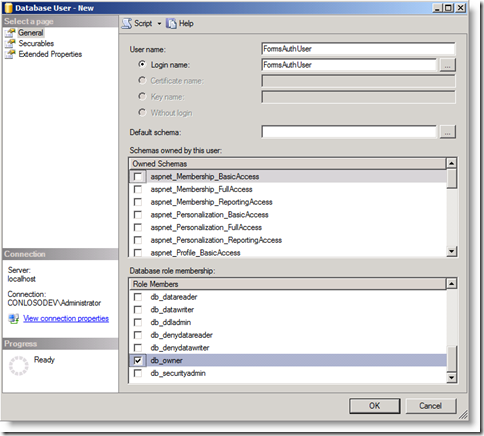
Enter the name, select Login name, and give this fella the role “db_owner”.
To recap:
We created a database called ConlosoDevFBA.
We created a SQL user called FormsAuthUser
We added FormsAuthUser to ASPNetFormsAuth database and gave them the db_owner role.
We’re done with SQL.
2. Configure Central Admin Web Site to use SQL Membership Provider
SharePoint web sites out of the box are configured to use Active Directory. So you may be wondering why we’re configuring Central Admin to use FBA when we don’t really want to login in as an FBA user. Well, we actually don’t want to configure it to to login as a forms user, but we do need to be able to add users from out membership database when configuring site collection admins, and the like.So all we want to do is tell the Central Admin web application to use our SQL membership provider as well as AD, so when you use the people picker to select users, it will provide results from our membership database.
Open IIS Manager on the WFE server (if more than one, then this needs to be done on every FWE that has Central Admin. The same goes for the proceeding steps for the other web applications).
Select the SharePoint Central Administration v4 site. On the Home Page, you’ll see many options for ASP.NET and IIS. The ones we’re concerned with are
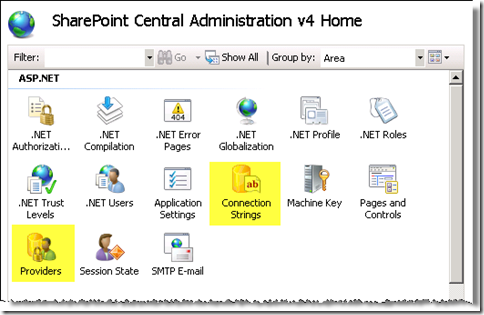
Open the Connection Strings Page. Under Actions menu on the right, select Add… to create a new connection string. Provide the details for the membership database for the new connection string.

Add Role Provider
Go back to the Web Application page and open up Providers page. Here we will create a provider for Roles and Users. Set feature to .NET Roles and click Add… in the Actions pane to add a new role provider. I called it FBARoleProvider and selected the right type and connection string.
Ensure you provide an ApplicationName so the provider knows what uses to authenticate. For a good explanation on why you need this, see Scott Guthrie’s blog.
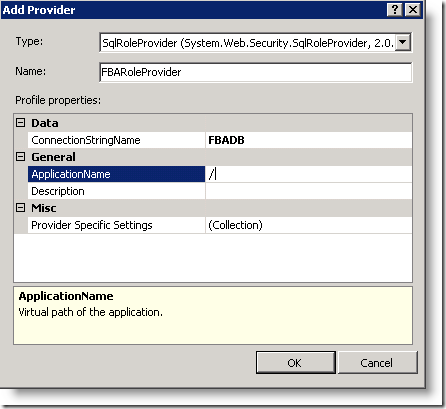
Add Membership Provider
Now set feature to .NET Users and click Add… from the actions pane to add a membership provider.

Select the correct type and connection string, and whatever behaviors you choose.
That’s it for the providers for Central Admin.
To verify that all looks ok, we can check the web.config of the web application. To get to the right web.config, right-click on the web application under sites, and select Explore.

In the web.config, you’ll see sections for the connection string and the providers. The <roleManager> and <membership> sections should look like:

You should also see a <connectionStrings> section close to the bottom of the web.config file.
3. Configure Secure Store Web Service to use SQL Membership Provider
Everything we did for Central Admin site, we are going to do for the SecurityTokenServiceAppliaation which is in the SharePoint Web Services application.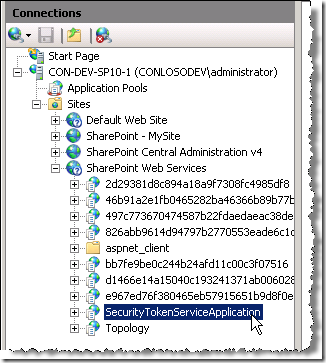
Without redo’ing all the steps:
- Create the connection string
- Add the .NET role provider
- Add the .NET users provider
- Verify connection by editing config.xml.
4. Create Extranet Web Application
Ok, finally we are ready to create our web application (called SharePoint – FBA) that will use FBA authentication.In Central Admin, Select the Application Management page, and select Manage web applications. Select New from the ribbon to create a new web application.
Select Claims Based Mode Authentication as Authentication Type. Select values for all the other options until you get to the “Enable Forms Based Authentication”.
Add the values we created earlier in the section “Enable Forms Based Authentication” for role and membership provider.
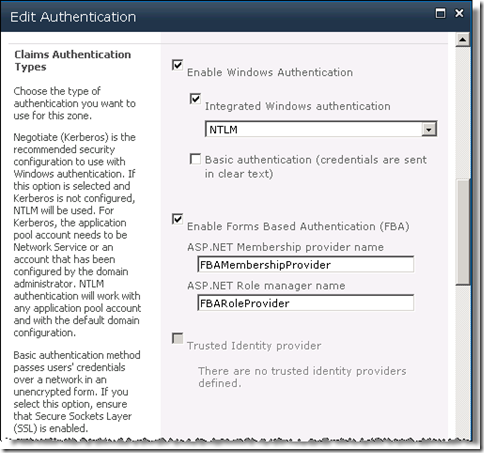
Once the application is created, we should create a site collection.
Create Site Collection
Go to the Create Site Collection page from the Manage Applications section in Central Admin. Select the team (or blank, or whichever you choose) template then select the site collection administrator. At this point, we should be able to select from our SQL membership users. Enter a user you know exists in the membership database and see if you can resolve the names.

I have a user with the same name in both AD and SQL, so I know I am hitting both.
Note:
I jumped ahead here and added users through IIS Manager. If you have
been following this article to the letter, then you will obviously not
see users in your membership database. Do not worry about this piece
for now, as you will add users to your membership store later.
At this point we have told SharePoint what role providers to use for
the web app, but we still need to configure the web app through IIS
manager to bind the providers.Configure Membership Providers for Web App through IIS
In IIS Manager, browse to the new site SharePoint – FBA. For our new FBA site we need to do the following:
- Add connection string
- Add Providers for members and roles
- Configure .NET Roles
- Configure .NET Users
- Set Authentication to Forms and Integrated
- Add User as Site Collection Admin
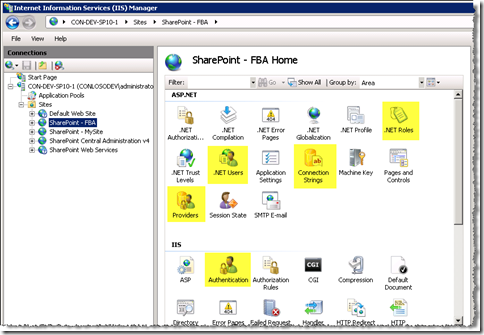
1. Add Connection String
Same as we have done before.
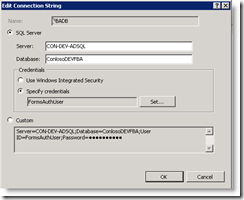
Note:
we could potentially just do this for the machine, and not have to do
it for every web application. I prefer to do it for every web app, as
I’ve had mixed results otherwise.
2. Add role and user providersAgain, same as what we did before. Open Providers page and add an entry for our role and user providers.
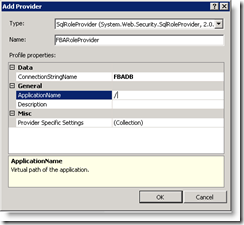

3. Configure .NET Roles
This and the next steps are not required for the other two web applications we configured (Central Admin and SSS).
Open the .NET Roles page for our web application. You will receive a warning that the default role provider is not trusted. WE just need to set our default role provider to FBARoleProvider.
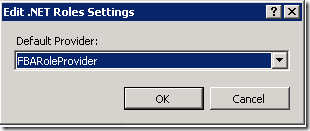
We do not have any roles in our database at this point, so let’s create two (StandardUser, SuperUser) by clicking Add… in the actions pane.
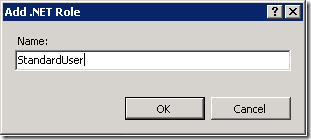
4. Configure .NET Users
Now we need to do the same for .NET Users. Open the .NET Users page. You will get a similar warning saying the default is not trusted. Set the default provider to FBAMembershipProvider. If you had members in the database, you would now see them listed. Assuming you don’t let’s add some. Click Add… from the Actions pane to add users, and assign them roles.

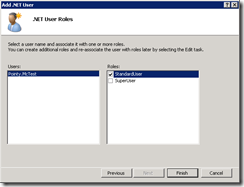
5. Set Authentication
SharePoint should have done this when you created the web application, but let’s confirm. From the web application home page in IIS Manager, select Authentication under the IIS section. Confirm that the web application has both Integrated and Forms enabled.
6. Add User as Site Collection Admin
Now that we have everything hopefully configured correctly, we can go back to SharePoint Central Admin and add our new user as the Site Collection Administrator. From Central Admin Application Management page, click Change site collection administrators. Select SharePoint – FBA root site collection, and add our new user.
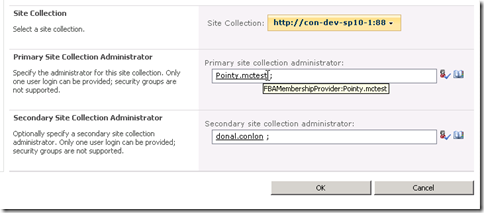
Now lets test all this business by trying to login. Browse to your site and select to login as a forms user.
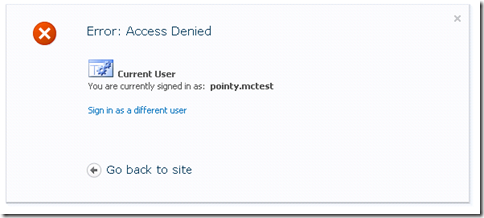
What the…?! I am authenticated ok, but am not allowed in, even though I’m a site collection admin?!
Caveat
Here’s the caveat – In order for you to use IIS Manager to manage your SQL users, you need to set the default provider to our Forms provider, i.e. FBAMembershipProvider. In order for it to work we need to set it to the SharePoint claims provider. Go back to .NET Users and reset the default provider to “i” which is for the Microsoft.SharePoint.Administration.Claims.SPClaimsAuthMembershipProvider
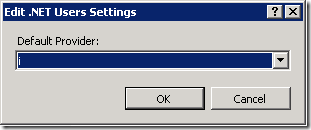
You
could work around this by creating another IIS web site, configure the
same way you did for SharePoint – FBA, and use that for managing users.
You should also check the
default Role Provider for the web application and ensure that is set to
“c”. If this is set to the SQL provider that you created, you will get
an unexpected error after you logon.Now let’s try to login again…

Success!!
To verify all of the above: here are the three web.config files in play:
Central Admin Web.config
<roleManager>
<providers>
<add name="FBARoleProvider" type="System.Web.Security.SqlRoleProvider, System.Web, Version=2.0.0.0, Culture=neutral, PublicKeyToken=b03f5f7f11d50a3a" applicationName="/" connectionStringName="FBADB" />
</providers>
</roleManager>
<membership>
<providers>
<add name="FBAMembershipProvider" type="System.Web.Security.SqlMembershipProvider, System.Web, Version=2.0.0.0, Culture=neutral, PublicKeyToken=b03f5f7f11d50a3a" applicationName="/" connectionStringName="FBADB" enablePasswordReset="true" enablePasswordRetrieval="false" passwordFormat="Clear" requiresQuestionAndAnswer="false" requiresUniqueEmail="false" />
</providers>
</membership>
<membership>
<providers>
<add name="FBAMembershipProvider" type="System.Web.Security.SqlMembershipProvider, System.Web, Version=2.0.0.0, Culture=neutral, PublicKeyToken=b03f5f7f11d50a3a" applicationName="/" connectionStringName="FBADB" enablePasswordReset="true" enablePasswordRetrieval="false" passwordFormat="Clear" requiresQuestionAndAnswer="false" requiresUniqueEmail="false" />
</providers>
</membership>
<roleManager>
<providers>
<add name="FBARolePRovider" type="System.Web.Security.SqlRoleProvider, System.Web, Version=2.0.0.0, Culture=neutral, PublicKeyToken=b03f5f7f11d50a3a" applicationName="/" connectionStringName="FBADB" />
</providers>
</roleManager>
<membership defaultProvider="i">
<providers>
<add name="i" type="Microsoft.SharePoint.Administration.Claims.SPClaimsAuthMembershipProvider, Microsoft.SharePoint, Version=14.0.0.0, Culture=neutral, PublicKeyToken=71e9bce111e9429c" />
<add name="FBAMembershipProvider" type="System.Web.Security.SqlMembershipProvider, System.Web, Version=2.0.0.0, Culture=neutral, PublicKeyToken=b03f5f7f11d50a3a" applicationName="/" connectionStringName="FBADB" enablePasswordReset="true" enablePasswordRetrieval="false" passwordFormat="Clear" requiresQuestionAndAnswer="false" requiresUniqueEmail="false" />
</providers>
</membership>
<roleManager cacheRolesInCookie="false" defaultProvider="FBARoleProvider" enabled="true">
<providers>
<add name="c" type="Microsoft.SharePoint.Administration.Claims.SPClaimsAuthRoleProvider, Microsoft.SharePoint, Version=14.0.0.0, Culture=neutral, PublicKeyToken=71e9bce111e9429c" />
<add name="FBARoleProvider" type="System.Web.Security.SqlRoleProvider, System.Web, Version=2.0.0.0, Culture=neutral, PublicKeyToken=b03f5f7f11d50a3a" applicationName="/" connectionStringName="FBADB" />
</providers>
</roleManager>
Information comes from Donal Conlon
Change SharePoint authentication from classic mode to claims based
Recently I was in a situation to enable form authentication for a SharePoint web application that was configured using classic mode authentication. So the solution for me is to change the authentication mode to claims based.
Caution: Be noted that once you migrated the authentication provider to claims based, you can not revert it back.
(In 2007 version, the option was to extend the web application on the same content database, and enable form authentication, but there were some troubles always as I need to deploy the dll to bin folder in both web applications, original and extended. Also there were other troubles for deploying smart parts. )
From the central administration, I checked the authentication provider and it is showing my current authentication provider as windows.

Now I am going to change my authentication provider, to do this, you need to use windows powershell.
From the start menu, go to
All Programs -> SharePoint 2010 products -> Sharepoint 2010 Management Shell

The power shell window is opened as follows.

Execute the following commands

Type Y for confirmation
After the command executed successfully, check the authentication provider from the central administration, it will show “claims based authentication”

Now execute the following commands.
Caution: Be noted that once you migrated the authentication provider to claims based, you can not revert it back.
(In 2007 version, the option was to extend the web application on the same content database, and enable form authentication, but there were some troubles always as I need to deploy the dll to bin folder in both web applications, original and extended. Also there were other troubles for deploying smart parts. )
From the central administration, I checked the authentication provider and it is showing my current authentication provider as windows.

Now I am going to change my authentication provider, to do this, you need to use windows powershell.
From the start menu, go to
All Programs -> SharePoint 2010 products -> Sharepoint 2010 Management Shell

The power shell window is opened as follows.

Execute the following commands
$WebAppName = “http://win-hgdsnnuakhv”When you execute this command, a confirmation message will appear on the screen as follows.
$account = "WIN-HGDSNNUAKHV\Administrator"
$wa = get-SPWebApplication $WebAppName
Set-SPwebApplication $wa –AuthenticationProvider (New-SPAuthenticationProvider) –Zone Default

Type Y for confirmation
After the command executed successfully, check the authentication provider from the central administration, it will show “claims based authentication”

Now execute the following commands.
- set the user as an administrator for the site
$wa = get-SPWebApplication $WebAppName
$account = (New-SPClaimsPrincipal -identity $account -identitytype 1).ToEncodedString()
- configure the policy to enable the user to have full access
$zp = $wa.ZonePolicies("Default")
$p = $zp.Add($account,"PSPolicy")
$fc=$wa.PolicyRoles.GetSpecialRole("FullControl")
$p.PolicyRoleBindings.Add($fc)
$wa.Update()
- perform user migration
$wa = get-SPWebApplication $WebAppNameReference: http://technet.microsoft.com/en-us/library/gg251985.aspx and http://weblogs.asp.net/sreejukg/archive/2011/03/25/change-sharepoint-authentication-from-classic-mode-to-claims-based.aspx
$wa.MigrateUsers($true)
Wednesday, March 23, 2011
SharePoint Foundation Master Page Picker
By Stu
I recently began a new SharePoint 2010 branding project that requires only SharePoint 2010 Foundation be used. If you have worked in a purely Foundation environment you have probably quickly realized that there are no tools in Site Settings to allow you to select an alternate Master Page. So how do you create a custom branded Foundation Site if you cannot even select your new Master Page for testing or deployment? I found a great solution in the “Foundation Master Page Picker” on CodePlex and here is how to set it up!
SharePoint branding requires a lot of trial and error development. You can always start by developing your front-end code as pure HTML and CSS but eventually you have to deploy the code to a master page and get it working in SharePoint. Once you have done this, it’s matter of testing and tweaking until you get it just right. SharePoint injects a number of CSS classes that can mess with even the cleanest markup and it’s never as easy as simply injecting your pristine code and calling it done.
But what about SharePoint 2010 Foundation sites? The intent with Foundation was to use the theme system to change the look and feel. This is very apparent when you look at the site settings. There are no options for selecting a new master page and rather than modifying the v4.master, wouldn’t it be better to leave that in place as a backup? Building a new master page with a name that fits your project is always preferable to modifying the existing or default master pages.
In my research I found a great solution on CodePlex called the SharePoint Foundation Master Page Picker. However, if you are not familiar with SharePoint administration installing and deploying a solution can be intimidating and there is at least one gotcha I found with this solution that you should know about.
Download the solution
To start with you need to go get the solution. Download it from CodePlex and save to a folder on your SharePoint server.
Install the solution
The next thing you need to do is install it. To do this you are going to use stsadm.exe. This is a command line application used to numerous administration tasks on your server.
1. Open a command prompt – you can select it from your program menu or select Start and type cmd in the “search programs and files” box
2. Navigate to stsadm – stsadm is located in the hive. In command prompt you navigate by typing “cd” followed by a space and folder you want to open. On my server the path to stsadm is: c:program filescommon filesmicrosoft sharedweb server extensions14bin

3. Install the solution – now that we are in the bin we can execute commands against stsadm. To install this solution you need to run the following command:
You should get a confirmation that the solution was successfully installed, if not, check your command for extra spaces or other simple errors and try it again.

4. Deploying the solution – The next step is to deploy the solution. There are things that need to go into the GAC and running the “deploysolution” command will do this for us. There is a very specific way in which you need to deploy this solution and I only discovered through trial and error. Use the following command to deploy the solution:

5. Activate the Feature – Installation and deployment are now complete, all we have to do now is turn the functionality on. This is a site collection feature so navigation to the site settings page of the top level site in your site collection. Under Site Collection administration you will find a link to Site Collection Features, click on this link and activate the Master Page Picker feature.

6. Select a new master page – You’re done! To select a new master page for your Foundation site, go to Site Settings>Look and Feel and select the Master Page Picker. You will see a list of available master pages allowing you to select the one you want and click OK to change the master page.

Once you have created your custom master page and dropped it into the master page gallery it too will appear on this list as an available option.
Information from Stu
I recently began a new SharePoint 2010 branding project that requires only SharePoint 2010 Foundation be used. If you have worked in a purely Foundation environment you have probably quickly realized that there are no tools in Site Settings to allow you to select an alternate Master Page. So how do you create a custom branded Foundation Site if you cannot even select your new Master Page for testing or deployment? I found a great solution in the “Foundation Master Page Picker” on CodePlex and here is how to set it up!
SharePoint branding requires a lot of trial and error development. You can always start by developing your front-end code as pure HTML and CSS but eventually you have to deploy the code to a master page and get it working in SharePoint. Once you have done this, it’s matter of testing and tweaking until you get it just right. SharePoint injects a number of CSS classes that can mess with even the cleanest markup and it’s never as easy as simply injecting your pristine code and calling it done.
But what about SharePoint 2010 Foundation sites? The intent with Foundation was to use the theme system to change the look and feel. This is very apparent when you look at the site settings. There are no options for selecting a new master page and rather than modifying the v4.master, wouldn’t it be better to leave that in place as a backup? Building a new master page with a name that fits your project is always preferable to modifying the existing or default master pages.
In my research I found a great solution on CodePlex called the SharePoint Foundation Master Page Picker. However, if you are not familiar with SharePoint administration installing and deploying a solution can be intimidating and there is at least one gotcha I found with this solution that you should know about.
Download the solution
To start with you need to go get the solution. Download it from CodePlex and save to a folder on your SharePoint server.
Install the solution
The next thing you need to do is install it. To do this you are going to use stsadm.exe. This is a command line application used to numerous administration tasks on your server.
1. Open a command prompt – you can select it from your program menu or select Start and type cmd in the “search programs and files” box
2. Navigate to stsadm – stsadm is located in the hive. In command prompt you navigate by typing “cd” followed by a space and folder you want to open. On my server the path to stsadm is: c:program filescommon filesmicrosoft sharedweb server extensions14bin

3. Install the solution – now that we are in the bin we can execute commands against stsadm. To install this solution you need to run the following command:
stsadm -o addsolution -filename c:{your folder name here}IBS.SharePointFoundation.Utilities.wspYou should get a confirmation that the solution was successfully installed, if not, check your command for extra spaces or other simple errors and try it again.

4. Deploying the solution – The next step is to deploy the solution. There are things that need to go into the GAC and running the “deploysolution” command will do this for us. There is a very specific way in which you need to deploy this solution and I only discovered through trial and error. Use the following command to deploy the solution:
stsadm -o deploysolution -name IBS.SharePointFoundation.Utilities.wsp -local -allowGacDeployment
5. Activate the Feature – Installation and deployment are now complete, all we have to do now is turn the functionality on. This is a site collection feature so navigation to the site settings page of the top level site in your site collection. Under Site Collection administration you will find a link to Site Collection Features, click on this link and activate the Master Page Picker feature.

6. Select a new master page – You’re done! To select a new master page for your Foundation site, go to Site Settings>Look and Feel and select the Master Page Picker. You will see a list of available master pages allowing you to select the one you want and click OK to change the master page.

Once you have created your custom master page and dropped it into the master page gallery it too will appear on this list as an available option.
Information from Stu
Wednesday, March 16, 2011
Scrolling not working in IE
Recently I have been trying to get my scroll bar work proin Internet explorer with CSS attribute and inline styling but I kept getting nowhere.
I finally found a way to fix it.
In my master page and by default in the master page, the <body> tag has a property called scroll.
By default that property looks like this <body scroll="no" onload="if (typeof(_spBodyOnLoadWrapper) != 'undefined') _spBodyOnLoadWrapper();" class="v4master">
Just change that scrool="no" to scroll="yes" and like magic the scrolling works :)
Hope this was helpful.
Furthermore you can add this script to the head:
This solution does two things: first, it will override the default appearance and behavior of the SharePoint interface, enabling scrollbars on your pages by default (much rejoicing is in order). Second, it keeps the ribbon fixed to your browser window using CSS (instead of JavaScript). Instead of resizing the
This should work on any master page that uses the “v4″ SharePoint interface. I’ll be using this method on every SharePoint site I create from this point forward, so definitely keep this in mind in your own SharePoint design ventures! Best of luck, and please let me know if this helps you in any way.
Part of this information was given by Kyle Schaeffer
I finally found a way to fix it.
In my master page and by default in the master page, the <body> tag has a property called scroll.
By default that property looks like this <body scroll="no" onload="if (typeof(_spBodyOnLoadWrapper) != 'undefined') _spBodyOnLoadWrapper();" class="v4master">
Just change that scrool="no" to scroll="yes" and like magic the scrolling works :)
Hope this was helpful.
Furthermore you can add this script to the head:
function FixRibbonAndWorkspaceDimensions(){
ULSxSy:;
g_frl = true;
var elmRibbon = GetCachedElement("s4-ribbonrow");
var elmWorkspace = GetCachedElement("s4-workspace");
var elmTitleArea = GetCachedElement("s4-titlerow");
var elmBodyTable = GetCachedElement("s4-bodyContainer");
if(!elmRibbon || !elmWorkspace || !elmBodyTable){
return;
}
if (!g_setWidthInited){
var setWidth = true;
if (elmWorkspace.className.indexOf("s4-nosetwidth") > -1)
setWidth = false;
g_setWidth = setWidth;
g_setWidthInited = true;
}
else{
var setWidth = g_setWidth;
}
var baseRibbonHeight = RibbonIsMinimized() ? 44 : 135;
var ribbonHeight = baseRibbonHeight + g_wpadderHeight;
if(GetCurrentEltStyle(elmRibbon, "visibility") == "hidden"){
ribbonHeight = 0;
} // Override default resizing behavior
// -- adds padding to the top of the "s4-workspace" <div> if the ribbon exists and has content
// -- allows the ribbon to be positioned using CSS instead of JavaScript (more accessible)
// -- checks to see if the page is inside a "no-ribbon" dialog
if(elmRibbon.children.length > 0 && document.getElementsByTagName("html")[0].className.indexOf('ms-dialog-nr') == -1){
elmWorkspace.style.paddingTop = ribbonHeight + 'px';
} And lastly add this to the stylesheet:
body.v4master {
overflow: visible;
height: inherit;
width: inherit;
}
body #s4-workspace {
overflow: visible !important;
}
body #s4-ribbonrow {
position: fixed;
z-index: 1000;
}
#s4-ribbonrow .ms-MenuUIPopupBody, #s4-ribbonrow .ms-popoutMenu, .ms-cui-menu[id ^= "Ribbon."] {
position: fixed !important;
}
.ms-dlgOverlay {
width: 100% !important;
}This solution does two things: first, it will override the default appearance and behavior of the SharePoint interface, enabling scrollbars on your pages by default (much rejoicing is in order). Second, it keeps the ribbon fixed to your browser window using CSS (instead of JavaScript). Instead of resizing the
s4-ribbonrow and s4-workspace divisions, I’m simply adding some padding to the top of the s4-workspace element. Every time the ribbon “resize” script runs, it bumps your content down a little to make sure you can still see your site header.This should work on any master page that uses the “v4″ SharePoint interface. I’ll be using this method on every SharePoint site I create from this point forward, so definitely keep this in mind in your own SharePoint design ventures! Best of luck, and please let me know if this helps you in any way.
Part of this information was given by Kyle Schaeffer
Tuesday, March 15, 2011
Customize the Display of Quick Launch (sharepoint 2010)
A number of options are available to developers who want to customize the appearance and behavior of Quick Launch, the menu in the left navigational area of pages in a Microsoft SharePoint Foundation website. One very commonly used technique is to modify attributes of the control that renders the Quick Launch menu. Another approach is to replace the menu control with an altogether different type of navigational control. This topic gives examples that use both methods.
Modifying the menu control
You can modify the appearance of Quick Launch by setting attributes on the AspMenu control that displays its navigational nodes. For example, you can set attributes that collapse the view of the menu to headings alone and add flyout menus for displaying subordinate menu levels.
The menu control is defined in the default master page for the website. To change characteristics of the menu, you must either customize the originally installed default master page or create a custom master page and set it as the default.
To display flyout menus by modifying the default master page
- Open your browser and navigate to the website that you want to customize.
- Click Site Actions, and then click Site Settings.
- In the Galleries section, click Master pages.
- Select v4.master. Then click Edit Document on the ribbon.
The master page opens in the default editor. If Microsoft SharePoint Designer 2010 is installed on your computer, the file opens in SharePoint Designer.
- Close your browser.
Note |
| You might not be allowed to save changes to the site's default master page if a site-mapped page is open. |
- Locate the Quick Launch menu control. You can find the control in code view by searching on the following string: <SharePoint:AspMenu id="V4QuickLaunchMenu"
- Set the value of the StaticDisplayLevels attribute and the MaximumDynamicDisplayLevels attribute to 1, as follows.
<SharePoint:AspMenu id="V4QuickLaunchMenu" runat="server"
EnableViewState="false" DataSourceId="QuickLaunchSiteMap"
UseSimpleRendering="true" UseSeparateCss="false" Orientation="Vertical"
StaticDisplayLevels="1" MaximumDynamicDisplayLevels="1"
SkipLinkText="" CssClass="s4-ql" />
By default, the StaticDisplayLevels attribute is set to 2. This means that when the page is rendered, the Quick Launch area of the left navigation bar has two menu levels: a series of headings and, below each heading, a set of child links. Changing the value to 1 means that only headings are shown.
The default value of the MaximumDynamicDisplayLevels attribute is 0. This disables flyout menus. Setting the value to 1 means that the first menu level below the last level on the static menu appears in a flyout menu. In this case, flyoutmenus appear for the first level below the headings.
- Save the file and open a page in the website to see the result of your changes.
To display flyout menus by creating a custom master page
- In SharePoint Designer 2010, open the website that you want to customize.
- In the Navigation pane, select Master Pages.
- Right-click v4.master, and then click Copy.
- Right-click an empty area of the Master Pages pane, and then click Paste.
The file v4_copy(1).master is created.
- Right-click v4_copy(1).master, click Rename, and type a new name, such as my.master.
- Open the new file for editing.
- Locate the Quick Launch menu control. You can find the control in code view by searching on the following string: <SharePoint:AspMenu id="V4QuickLaunchMenu"
- Set the value of the StaticDisplayLevels attribute and the MaximumDynamicDisplayLevels attribute to 1, as follows.
<SharePoint:AspMenu id="V4QuickLaunchMenu" runat="server"EnableViewState="false" DataSourceId="QuickLaunchSiteMap"UseSimpleRendering="true" UseSeparateCss="false" Orientation="Vertical"StaticDisplayLevels="1" MaximumDynamicDisplayLevels="1"SkipLinkText="" CssClass="s4-ql" />
- On the File menu, click Save.
Note |
| You might not be allowed to save changes to the site's default master page if a site-mapped page is open in the browser. If this occurs, close the browser and try again. |
- In the Navigation pane, select Master Pages.
- Right-click the name of your master page, and then click Set as Default Master Page.
Note |
| You can also set a custom master page as the default master by writing code that sets the value of the SPWeb.MasterUrl property. |
- Open a page in the website to see the result of your changes.
Replacing the Menu Control
You can replace the AspMenu control with another control, such as the SPTreeView control that displays a tree of nodes that collapse and expand.
To replace the Menu control with a TreeView control
- In SharePoint Designer 2010, open the website that you want to customize.
- In the Navigation pane, select Master Pages.
- Right-click v4.master, and then click Copy.
- Right-click an empty area of the Master Pages pane, and then click Paste.
The file v4_copy(1).master is created.
- Right-click v4_copy(1).master, click Rename, and type a new name, such as my.master.
- Open the new file for editing.
- Locate the Quick Launch menu control. You can find the control in code view by searching on the following string: <SharePoint:AspMenu id="V4QuickLaunchMenu"
- Right click V4QuickLaunchMenu, select Select Tag, and then press the Delete key.
- Replace the deleted markup with markup for three new controls, an SPHierarchyDataSourceControl and an SPRememberScroll control that contains an SPTreeView control.
<SharePoint:SPHierarchyDataSourceControl
id="MyTreeViewDataSource"
runat="server" RootContextObject="Web"
IncludeDiscussionFolders="true" />
<SharePoint:SPRememberScroll
id="MyTreeViewRememberScroll"
runat="server" onscroll="javascript:_spRecordScrollPositions(this);"
Style="overflow: auto;height: 400px;width: 150px; ">
<SharePoint:SPTreeView
id="MyWebTreeView"
runat="server"
ShowLines="true"
DataSourceId="MyTreeViewDataSource"
ExpandDepth="3"
SelectedNodeStyle-CssClass="ms-tvselected"
NodeStyle-CssClass="ms-navitem"
NodeStyle-HorizontalPadding="2"
NodeStyle-VerticalPadding="5"
SkipLinkText=""
NodeIndent="20"
ExpandImageUrl="/_layouts/images/tvplus.gif"
CollapseImageUrl="/_layouts/images/tvminus.gif"
NoExpandImageUrl="/_layouts/images/tvblank.gif" />
</SharePoint:SPRememberScroll>
This markup expands the top three nodes by default, specifies lines drawn between nodes, and specifies values for vertical padding and indentation.
- On the File menu, click Save.
Note |
| You might not be allowed to save changes to the site's default master page if a site-mapped page is open in the browser. If this occurs, close the browser and try again. |
- In the Navigation pane, select Master Pages. Right-click the name of your master page, and then click Set as Default Master Page.
- Open a page in the website to see the result of your changes.
Wonderful information from msdn
Subscribe to:
Comments (Atom)